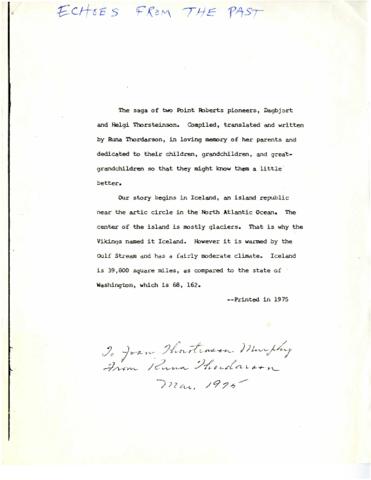Identity elements
Reference code
Name and location of repository
Level of description
Title
Date(s)
- 1975 (Creation)
Extent
Content and structure elements
Scope and content
A photocopy of a twenty-seven page typed biography of two Point Roberts pioneers, Dagbjort and Helgi Thorsteinson. Compiled, translated, and written by Runa Thordarson. Also included are photocopied portraits of Helgi and Dagbjort and a photo of their home in Point Roberts from a newspaper clipping (the newspaper cites their surname as Thorstenson).
System of arrangement
Conditions of access and use elements
Conditions governing access
Physical access
Technical access
Conditions governing reproduction
Languages of the material
Scripts of the material
Language and script notes
Finding aids
Acquisition and appraisal elements
Custodial history
Immediate source of acquisition
Appraisal, destruction and scheduling information
Accruals
Related materials elements
Existence and location of originals
Existence and location of copies
Related archival materials
Related descriptions
Notes element
General note
Biographical Note
Dagbjort Dagbjartsdottir (1862-1941) and Helgi Thorstenson (1859-1945) grew up together as farm hands on an estate belonging to Gunnlaugur Arnoddson and Elsa Dorothea Thordardottir in Myrdal, Iceland. In 1887, Helgi and Dagbjort (Daga for short) now engaged, decided to immigrate to Canada where their friends had gone a decade earlier. They took the ship, Camoens, to Scotland and then another ship to Newfoundland. From there they traveled by train to Vancouver and took a final boat to Victoria.
In Victoria they stayed with their friends from Iceland, Sigurdur and Valgerdur Myrdal. Helgi got work in a lumber mill and Daga did housework. In 22 December 1888, Helgi and Daga were married. They moved into a little house built by Helgi in Victoria’s Icelandic community. On 15 August 1889 Daga gave birth to a baby boy. He was born premature and died the following day. On 4 August 1890 their second child was born, a girl named Groa for Daga’s mother.
In 1891 Helgi and Daga sent for Daga’s mother. She traveled alone and lived with them for the rest of her life. Helgi and Daga joined the Icelandic Literary Society and were active in their Lutheran congregation, which eventually became the first Lutheran Church on the Pacific Coast. In the spring of 1893 another child was born, a son named Gunnlaugur. He caught cholera and died on 2 September 1893.
In 1894 Helgi and some friends went to investigate Point Roberts. He decided to settle there and purchased a house. There was a depression in Victoria and little work. They had another daughter, Gudrun (Runa) and another son named Gunnlaugur (Laugi). Helgi worked in the Alaska Packers Association of California cannery and he and Daga farmed as well. In 1899 Helgi started building a new house. They moved in in 1900 and also welcomed another son, Jonas. 1900 was also the year they became United States citizens. Daga had a natural ability for nursing and helped many of the pioneers over the years. Helgi and Daga eventually formed a literary society called Hafstjarnan (Ocean Star). They created a library of which Daga was secretary for many years.
In 1903 another daughter was born named Elsa Dorothea. In 1908, after years of uncertainty, Point Roberts was opened by President Roosevelt for homesteaders. Prior to this, the community fought legislation that would have removed them for the building of a fort. Helgi went to Seattle to the land office to formally lay claim to their Point Roberts homestead. The community sent a tanned rug made from a pig to President Roosevelt as thanks. In the 1930s fish traps were outlawed and the canneries closed. Helgi went into the poultry business and sold eggs to Bellingham. Helgi and Daga lived in Point Roberts for the rest of their lives.

